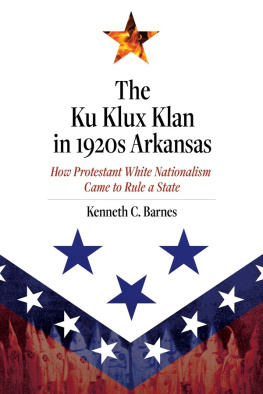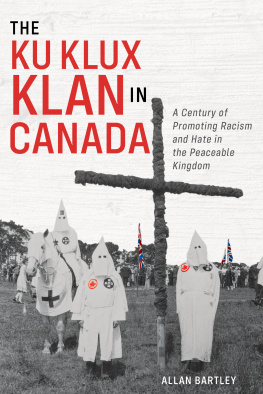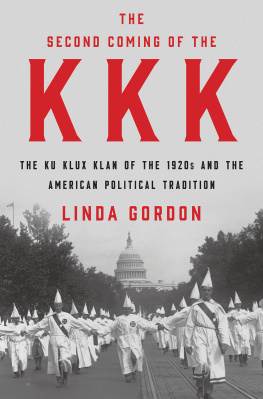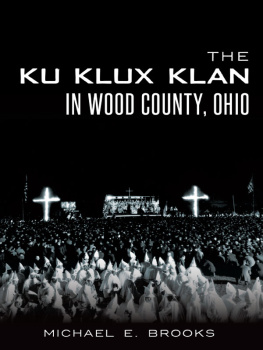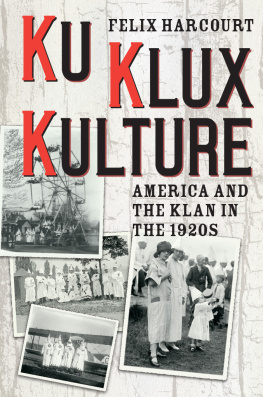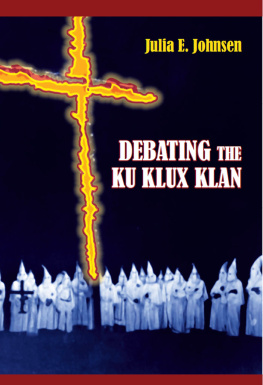1990 by The Kent State University Press, Kent, Ohio 44242
All rights reserved
Library of Congress Catalog Card Number 90-34701
ISBN 0-87338-415-6
ISBN 0-87338-694-9 (pbk.)
Manufactured in the United States of America
First paperback edition, 2000.
This is a Docutech Xerographic edition of the first printing.
Library of Congress Cataloging-in-Publication data
Jenkins, William D., 1941
Steel valley klan: the Ku Klux Klan in Ohios Mahoning Valley / William D. Jenkins
p. cm.
Includes bibliographical references (p. ).
ISBN 0-87338-415-6 (alk. paper)
ISBN 0-87338-694-9 (pbk.)
1. Ku Klux Klan (1915 ) Mahoning River Valley (Ohio and Pa.)History.
2. Mahoning River Valley (Ohio and Pa.)History.
1. Title.
HS2330.K63J44 1990 90-34701
322.4'2'0977139dc20 CIP
British Library Cataloging-in-Publication data are available.
Secrecy has often clouded our knowledge of the operations of the Ku Klux Klan during the 1920s. Because meeting records and membership rosters disappeared once the Klan began to decline, historians interested in the Klan have had to rely on insiders accounts, court records, congressional hearings, contemporary observations of journalists and students, and, of course, newspaper accounts. Although the credibility of these sources varies, as well as the extent to which historians have utilized them in constructing a comprehensive portrait, there have emerged a number of generalizations regarding the Klan about which most historians can agree.
The Ku Klux Klan of the 1920s was an intolerant fraternal society composed of white, Anglo-Saxon Protestants. Members located in both rural and urban areas resented blacks, immigrants, Catholics, and Jews. The leadersin particular the founder, William Simmons, his successor, Hiram Evans, recruiter Edward Y. Clarke, and D. C. Stephensonwere personally corrupt and more interested in power or money than in a cause. Scandals involving these leaders alienated many members and prompted the decline of the Klan. The opposition of Irish and Italian Catholics, funneled through the American Unity League and its tactics of stealing and publishing membership lists, also played a vital role in its decline.
Although most historians can agree with the above generalizations, it is troubling to note that such conclusions rest upon research still sparse in its coverage. Because of the paucity of documents and the tediousness of searching through newspapers, only a few historians have undertaken in-depth studies of local Klans. Thus, a synthesis
Both Charles C. Alexander and Robert A. Goldberg have produced local studies based on a more intensive use of available sources; both raise questions about our present understanding of the Klan. In Oklahoma, Texas, Arkansas, and Louisiana, the southwestern portion of the Klan empire, Alexander discovered a Klan that flourished in spite of the small numbers of immigrants and blacks in those states. Although Klan rhetoric included more than a sprinkling of prejudice, its growth depended on its moral authoritarianism and its efforts to enforceeven by extralegal and violent meanslaws regulating the vices of the community. According to Alexander most Klan members blamed local government officials for failure to enforce the laws properly. Thus, they thought it quite proper to assume the role of enforcer. Laws regulating sex, marriage, and drinking were their primary concern. They took little direct action against Catholics, Jews, or blacks unless they were involved in violations of the law.
Goldberg has studied Colorado, an area remote from the flood of immigration affecting the eastern industrial states, yet the Klan was as powerful there as in Indiana, long considered one of the Klan strongholds. Because of the availability of evidence, Goldberg limited his study to five cities, each of which differed in its response to the Klan. It is Goldbergs contentionindeed, it is his main pointthat the Klan fed on local, rather than national, concerns and that each appearance of the Klan requires intensive study of local documents to understand its appeal.
This study of the Ku Klux Klan in the Mahoning Valley, located in northeast Ohio, represents an effort to continue the work begun by Alexander and Goldberg. It is hoped that its conclusions will become part of a more comprehensive synthesis regarding the Klan of the 1920s.
Historians have often treated the Klan as peculiar to the twenties. Following Arthur Schlesingers model of alternating cycles of liberalism and conservatism, these historians have cited the Klans rise as evidence of the lessening ability of religious, ethnic, and racial groups to live together in the Tribal Twenties. They also cite the passage of the Immigration Restriction Act of 1924 as a culmination of the movement to maintain white, Anglo-Saxon supremacy in the United States. Their studies point to World War I and its nationalistic tendencies, the Red Scare after the war, and the labor strife of 1919 as generators of the frictions that produced the Klan.that, although the war and subsequent events were certainly irritants, the Klan is best seen as a consequence of a cultural conflict that resulted from the overly rapid mixing of divergent cultures within a society already undergoing the wrenching changes of industrialization. The conflict became evident in the 1890s and intensified during the Progressive Era. The passage of a literacy testblocked by presidential vetoes until the advent of World War Iand the activities of the Anti-Saloon League were indicators of the escalation of the conflict. The Klan was a culmination, not a sudden flowering.
This study has benefited from the work of Richard Jensen and Paul Kleppner regarding pietistic Christianity and its involvement in politics. Both men have moved beyond traditional interpretations that highlight economic explanations for membership in political parties to a synthesis that includes moral and ethnic reasons as well. Their most important theme is the idea that pietistic Protestants have continuously involved themselves in midwestern politics as a means of imposing a conservative moral code on American society. Methodists, Baptists, Presbyterians, Disciples of Christ, and Scandinavian Lutherans constituted the pietistic sects; they emphasized personal conversion and revivals over the doctrinal and liturgical emphases of the Episcopalians and German Lutherans. Less concerned about achieving perfection in this world, these liturgicals relied on the moral authority of the church rather than the legal imperatives of the state to transform individual members. Jensen noted also that in 1890 pietists outnumbered liturgicals by two to one in Ohio and Indiana, later the centers of midwestern Klan activity.
The efforts of these pietists to serve as their brothers keeper began with Puritan New England and continued in the new republic.
In the 1870s pietists formed the Prohibition party, which advocated federal action to outlaw liquor, as well as legislation to promote a Christian Sabbath, use of the Bible in the public schools, and curtailment



